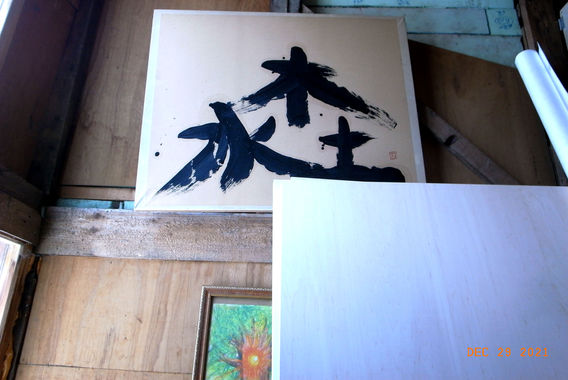Akira/Tokiko Tokumura
Akira Tokumura (commonly known as Ojiji) Born in 1928, Tokiko Tokumura (commonly known as Obaba) Born in 1933 / In 1964, opened a bookstore in Hiyoshi, Yokohama. 1971 Rejoiced at the book "Children's Library" by Momoko Ishii, a children's literary writer, and opened her own shop and home to create "Himawari Bunko". The 500 children who gathered there will blow away the wall of the "bunko movement" and create a "place where you can do whatever you want." In 1983, the children opened the "Forest Children's Village" in Takinoue Town and Takinoue District in search of a forest (water and soil on trees, hereinafter referred to as "forest") in search of their further possibilities and creativity. do. Since then, he has spent 38 years facing the forest and the lives of children.

Forests are places where diverse life lives.
It was December 29th that I visited "Forest Children's Village" in Takinoe, Takinoe Town. Although there is little snow in Okhotsk this year, the village of "Kumaide no Sawa" was completely buried in the snow at the innermost part of Okhotsk, which is closer to Teshio and the mountains of heavy snow from Takinishi. Since 1991, Mr. and Mrs. Tokumura have spent their time in this forest hut, where there is no electricity or gas. Now that Mr.Tokumura, so called Ojiji is 93 years old and Mrs. Tokumura, so called Obaba is 88 years old, my Ojiji goes to this forest 365 days a year, even though he has moved to the "bunko" of the village. Today as well, I will light the Goemon bath at 10 am and have a hot bath at 1 pm. In other words, we enter this forest twice a day.
"Forest Children's Village" is, so to speak, a summer camp for children. At the beginning of the village, 700 to 800 children spend a summer in this forest every year, and before the Corona disaster, 100 to 200 children spend a summer in this forest. Similar summer camps may be everywhere, but it's hard to believe that they have been around for 38 years. Even though there is no such thing as an organization to run, children get together just by connecting with them, and they come for years.
It can be said that "not" is the greatest power to establish a village. No organization, no rules, no leaders, no programs. There are only morning meetings and evening food distribution. Because of "nothing", children make the most of their sensibilities, five senses and six senses to face the forest, play with the forest, be embraced by the forest, and create their own satisfaction.
The important thing in the word "forest"
Of course, thier way of wrinting letter "forest (tree,water and soil)" is not in the dictionary. It is a character born from the relationship with the Ojiji's forest, and is the basis of the Ojiji's thought. Ojiji talks about why the "forest" consists of "trees, water, and soil." "A forest is not a place with many trees. There is a lot of life between trees, water and soil, and a forest where life is nurtured. There is no distinction between life, and no one is the same. , Forest life does not sacrifice any other life. The lack of any life will hurt the forest ecosystem. "
When I heard this story, I thought, "This" children's village "is the same as" Himawari Bunko. " You can understand everything by replacing the "life of the forest" that Ojiji talked about with "children." The reason why the children gathering at the "Himawari Bunko" strongly demanded the "Forest Children's Village".
The life and happiness that the forest gives.
Ojiji told me why the children came here so many times. "It may be tough, but I feel a sense of happiness. You can feel it just by standing by a tree, even though it's nothing. Children can feel deeper than I am old. Even if you don't realize "that's right"
I definitely feel it. That's why I come many times. "
From 1960 to 1980, the "bunko movement" was launched nationwide, and thousands of paperbacks were created. However, "Himawari Bunko" has overcome the "Bunko Movement for Good Children" at once. The behavioral principles of Ojiji and Obaba, "children are the main characters" and "create a place where children can do what they want to do," are "adults."
The view of education that "growth is to be adapted to the group and society" will eventually be an accusation that the child's individuality and potential, that is, "life" is undermined.
Children who have come to the "Forest Children's Village" are now the core of the town of Takinoue, where they live and live, make cheese, raise turkeys, raise hackers, create tourism, and build vitality in the town. It has received great trust and expectations from the townspeople. Ojiji calls them "because they fell in love with the forest." Through the forest
It's a word full of happiness that makes you meet people, sympathize with the forest, and turn your soul upside down.
It is said that Ojiji raises his body soaked in the Goemon bath and prays to the god of the forest. "Thank you for keeping me alive today as well. May the souls of all who connect with us and those who have died be peaceful."
At first, I was planning to go back to the village's "bunko" to hear this interview, but I heard it at the hut in Kumaidesawa after Ojiji's bath. It was a long interview, and due to his physical condition, I canceled the interview at "Bunko". As a result, I am sorry that I could not hear the story of Obaba. Please forgive me.
\ The person who wrote this article /
Shinichi Chonan / Born in Kitami City, spent 27 years in Tokyo from university and made a U-turn in 2000. Impressed by the splendor of Okhotsk, he rushed to revitalize the Okhotsk area. Representative of tomorrow's Okhotsk Claboratory.




